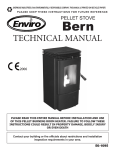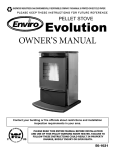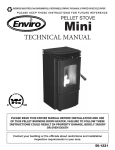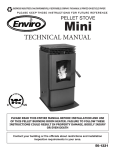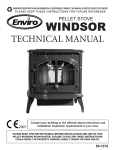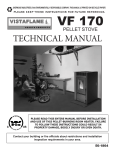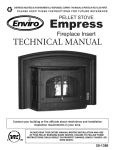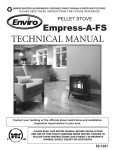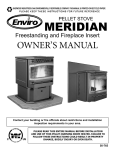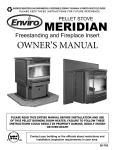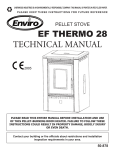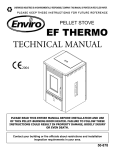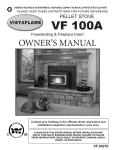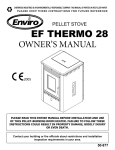Download Enviro 50-1574 Owner`s manual
Transcript
SHERWOOD INDUSTRIES IS AN ENVIRONMENTALLY RESPONSIBLE COMPANY. THIS MANUAL IS PRINTED ON RECYCLED PAPER. PLEASE KEEP THESE INSTRUCTIONS FOR FUTURE REFERENCE PELLET STOVE Evolution TECHNICAL MANUAL ���� PLEASE READ THIS ENTIRE MANUAL BEFORE INSTALLATION AND USE OF THIS PELLET BURNING ROOM HEATER. FAILURE TO FOLLOW THESE INSTRUCTIONS COULD RESULT IN PROPERTY DAMAGE, BODILY INJURY OR EVEN DEATH Contact your building or fire officials about restrictions and installation inspection requirements in your area. 50-1574 Table of Contents Safety Warnings & Recommendations...............................................................................................3 Installation.....................................................................................................................................6 Rating Label Location................................................................................................................6 Deciding Where to Locate your Pellet Appliance..........................................................................6 Removing Pellet Stove From Pallet.............................................................................................6 Dimensions..............................................................................................................................7 Clearances to Combustibles.......................................................................................................8 Alcove Clearances.....................................................................................................................8 Hearth Pad Pedestal Installation.................................................................................................9 Vent Termination Requirements................................................................................................10 Outside Fresh-Air Connection...................................................................................................11 Exhaust And Fresh Air Intake Locations....................................................................................11 Mobile Home Installation.........................................................................................................12 Corner Through Wall Installation..............................................................................................12 Horizontal Exhaust Through Wall Installation.............................................................................13 Through Wall With Vertical Rise and Horizontal Termination Installation- Recommended..............14 Through Concrete Wall With Vertical Rise Installations...............................................................14 Inside Vertical Installations......................................................................................................15 Outside Vertical Installations....................................................................................................15 Hearth Mount Installation........................................................................................................16 Exterior Mounted Exhaust Blower.............................................................................................17 Typical Through Wall With Exterior Blower Kit Installation - Horizontal Termination......................18 Typical Through Wall With Exterior Blower Kit Installation - Vertical Termination..........................19 Thermostat Installation............................................................................................................20 Optional Slider/Damper Installation..........................................................................................20 Slider/Damper Set-Up..............................................................................................................21 Troubleshooting............................................................................................................................22 Wiring Diagram.............................................................................................................................25 Parts List......................................................................................................................................26 Parts Diagram - Components..........................................................................................................28 Parts Diagram - Steel.....................................................................................................................29 Installation Data Sheet..................................................................................................................30 2 Safety Warnings & Recommendations * This manual is designed for the technician in conjunction with the owner’s manual. * Please read this entire Owner’s Manual before installing or operating your ENVIRO Pellet Stove. Failure to follow these instructions may result in property damage, bodily injury or even death. Any unauthorized modification of the appliance or use of replacement parts not recommended by the manufacturer is prohibited. All national and local regulations and European Standards shall be complied with when installing this appliance. Caution: Do not connect to any air distribution duct or system. Warning: Parts of the appliance, especially the external surfaces, will be hot to touch when in operation so use due care and the fire gloves provided. Never place wood, paper, furniture, drapes or other combustible materials within 80cm (311⁄2”) of the front of the unit, 20cm (77⁄8”) from each side, and 10cm (4”) from the back of the unit. Do not let children or pets touch it when it is hot. To prevent the possibility of a fire, ensure that the appliance is properly installed by adhering to the installation instructions. An ENVIRO dealer will be happy to assist you in obtaining information with regards to your local building codes and installation restrictions. FIRE EXTINGUISHER AND SMOKE DETECTION: All homes with a pellet burning stove should have at least one fire extinguisher in a central location known to all in the household. Smoke detectors should be installed and maintained in the room containing the stove when installing and operating a pellet burning appliance. If it sounds the alarm, correct the cause but do not deactivate. You may choose to relocate the smoke detection devise within the room; DO NOT REMOVE THE SMOKE DETECTOR FROM THE ROOM. CHIMNEY OR RUN AWAY FIRE: Call local fire department. Close the draft fully. Extinguish the fire in the burn pot liner with a cup of water and close the door. Examine the flue pipes, chimney, attic, and roof of the house, to see if any part has become hot enough to catch fire. If necessary, spray with fire extinguisher or water from the garden hose. IMPORTANT: Do not operate the stove again until you are certain the chimney and its lining have not been damaged. FUEL: This pellet stove is designed and approved to only burn wood pellet fuel with up to 3% ash content. Dirty fuel will adversely affect the operation and performance of the unit and may void the warranty. Check with your dealer for fuel recommendations. THE USE OF CORDWOOD IS PROHIBITED BY LAW. When filling fuel hopper, open lid on top of unit, check hopper for foreign objects, empty the bag into the hopper, DO NOT OVER FILL, and ensure hopper lid closes completely. DO NOT use this appliance as an incinerator. DO NOT use unsuitable and non recommended fuels, including liquid fuels. KEEP ASH PAN FREE OF RAW FUEL. DO NOT PLACE UNBURNED OR NEW PELLET FUEL IN ASH PAN. A fire in the ash pan may occur. SOOT: Operation of the stove with insufficient combustion air will result in the formation of soot which will collect on the glass, the heat exchanger, the exhaust vent system, and may stain the outside of the house. This is a dangerous situation and is inefficient. Frequently check your stove and adjust the slider/ damper as needed to ensure proper combustion. See: “SLIDER/DAMPER SETTING”. 3 Safety Warnings & Recommendations CLEANING: There will be some build up of fly ash and small amounts of creosote in the exhaust. This will vary due to the ash content of the fuel used and the operation of the stove. It is advisable to inspect and clean the exhaust vent semi-annually or every two tons of pellets. The appliance, flue gas connector and the chimney flue require regular cleaning. Check them for blockage prior to re-lighting after a prolonged shut down period. ASHES: Disposed ashes should be placed in a metal container with a tight fitting lid. The closed container of ashes should be on a non-combustible surface, well away from all combustible materials pending final disposal. If the ashes are disposed of by burial in soil or otherwise locally dispensed, they should be retained in the closed container until all cinders have been thoroughly cooled. IMPORTANT: The door and ash drawer cover must be kept closed except during ignition, refueling and removal of residue material to prevent fume spillage. GLASS: Do not abuse the glass by striking or slamming the door. Do not attempt to operate the stove with broken glass. The stove uses ceramic glass. Replacement glass must be purchased from an ENVIRO dealer. Do not attempt to open the door and clean the glass while the unit is in operation or if glass is hot. To clean the glass, use a soft cotton cloth and mild window cleaner, gas or wood stove glass cleaner, or take a damp paper towel and dip into the fly ash. This is a very mild abrasive and will not damage the glass. ELECTRICAL: The use of a surge protected power bar is recommended. The unit must be grounded. The grounded electrical cord should be connected to a standard 220-240 volts (2.0-2.3 Amps), 50 hertz electrical outlet and also must be accessible. If this power cord should become damaged, a replacement power cord must be purchased from the manufacturer or a qualified ENVIRO dealer. Be careful that the electrical cord is not trapped under the appliance and that it is clear of any hot surfaces or sharp edges. This unit’s maximum power requirement is 525 watts. OPERATION: The door and ash drawer cover must be kept closed securely when the unit is in operation to prevent fume spillage and for proper and safe operation of the pellet stove. Also ensure all gaskets on the door are checked and replaced when necessary. CAUTION: When operating during adverse weather, if the unit exhibits dramatic changes in combustion stop using the unit immediately. INSTALLATION: Contact your local building or fire official to obtain a permit and any information on installation restrictions and inspection requirements for your area. All local regulations, including those referring to national and European Standards need to be complied with when installing this appliance. Be sure to maintain the structural integrity of your home when passing a vent through walls, ceilings, or roofs. It is recommended that the unit be secured into its position in order to avoid any displacement. This appliance must be installed on a floor with an adequate load bearing capacity. If an existing construction doesn’t meet these prerequisite, suitable measures (e.g. load distributing plate) shall be taken to achieve it. DO NOT INSTALL A FLUE DAMPER IN THE EXHAUST VENTING SYSTEM OF THIS UNIT. DO NOT CONNECT THIS UNIT TO A CHIMNEY FLUE SERVING ANOTHER APPLIANCE. 4 Safety Warnings & Recommendations FRESH AIR: Outside Fresh Air connection is optional. Fresh Air must be connected to all units installed in “Air Tight Homes” or where required by local codes. Consider all large air moving devices when installing your unit and provide room air accordingly. NOTE: Extractor fans when operating in the same room or space as the appliance, may cause problems. Limited air for combustion may result in poor performance, smoking and other side effects of poor combustion. The stove’s exhaust system works with negative combustion chamber pressure and a slightly positive chimney pressure. It is very important to ensure that the exhaust system be sealed and airtight. The ash pan and viewing door must be locked securely for proper and safe operation of the pellet stove. Do not burn with insufficient combustion air. A periodic check is recommended to ensure proper combustion air is admitted to the combustion chamber. Setting the proper combustion air is achieved by adjusting the slider damper located on the left side of the stove. Minor soot or creosote may accumulate when the stove is operated under incorrect conditions such as an extremely rich burn (black tipped, lazy orange flames). If you have any questions with regards to your stove or the above-mentioned information, please feel free to contact your local dealer for further clarification and comments. SINCE SHERWOOD INDUSTRIES LTD. HAS NO CONTROL OVER THE INSTALLATION OF YOUR STOVE, SHERWOOD INDUSTRIES LTD. GRANTS NO WARRANTY IMPLIED OR STATED FOR THE INSTALLATION OR MAINTENANCE OF YOUR STOVE. THEREFORE, SHERWOOD INDUSTRIES LTD. ASSUMES NO RESPONSIBILITY FOR ANY CONSEQUENTIAL DAMAGE(S). SAVE THIS INSTRUCTION MANUAL FOR FUTURE REFERENCE 5 Installation RATING LABEL LOCATION: The rating label is located on the inside of the ash pan cover. DECIDING WHERE TO LOCATE YOUR PELLET APPLIANCE: 1. Check clearances to combustibles. 2. Do not obtain combustion air from an attic, garage or any unventilated space. Combustion air may be obtained from a ventilated crawlspace. 3. Do not install the stove in a bedroom. 4. You can vent the stove through an exterior wall behind the unit or connect it to an existing masonry or metal chimney (must be lined if the chimney is over 15 cm (6”) diameter, or over 180 cm² (28 inches²) cross sectional area). An interior vent can be used with approved pipe passing through the ceiling and roof. 5. Locate the stove in a large and open room that is centrally located in the house. This will optimize heat circulation. 6. The power cord is 2.43 m (8 feet) long and may require a grounded extension cord to reach the nearest electrical outlet. REMOVING PELLET STOVE FROM PALLET: Remove the two (2) wood screws (one on either side of the unit) to remove the unit from the pallet. 1. Remove the right and left hand cabinet sides by loosening the three (3) T-20 Torx screws on the back of the each panel. 2. Remove the one (1) screw located on the front of the cabinet side, behind the top louvers and one (1) screw behind the ash door. 3. Remove the two (2) wood screws that are holding the bottom of the stove to the pallet. 4. Close the side panels. Figure 1: Screws to take out to remove stove from pallet. 6 Installation DIMENSIONS: 27 7/8" (708 mm) Unit Dimensions Height: 840 mm (33 1/16”) Width: 565 mm (22 1⁄4”) Depth: 539 mm (21 1⁄4”) Hearth Pad: Width: 619 mm (24 3⁄8”) Depth: 708 mm (27 7⁄8”) IMPORTANT: When not installing the optional Hearth Pad on the unit, the minimum requirements for protection on combustibles floors are a width of 620mm (243⁄8”) & depth of 670mm (263⁄8”) under the unit. 24 3/8" (619 mm) 21 1/4" (539 mm) 22 1/4" (565 mm) 5 13/16" (147 mm) 33 1/16" (840 mm) 26 3/8" (670 mm) Figure 1: Dimensions of Evolution. Table 1: Evolution Specifications. Classification Testing Standard Description Class I IP-20 EN14785:2006/EN13240:2001/A2:2004 Residential Wood Pellet Heater Voltage Current Frequency 220 - 240 V 2.0 - 2.3 Amps 50 Hz Maximum Power Requirement Fuel type Calorific value of Pellet used 525W (1793 BTU/hr) wood pellets - 6mm (1⁄4”) dia. ≥ 5.10 kWh/kg (≥ 7900 BTU/lb) Maximum Flue Gas Temperature Mean Flue Gas Temperature Mean Flue Gas Temperature (Reduced) 200°C (392°F) 192°C (378°F) 143°C (289°F) Nominal Heat Output CO emissions from Combustion Energy Efficiency 7.6 KWh (25932 BTU) 0.032% 84% Reduced Heat Output CO emissions from Combustion (Reduced Output) Energy Efficiency (Reduced Output) 3.2 KWh (10919 BTU) 0.045% 75% CO2 at Nominal Output Nominal Fuel Consumption Rate Unit with Full Hopper 8.35% 1.78 Kg/hr (3.95 lb/hr)* ~ 140kg (310lb) CO2 at Reduced Output Fuel Consumption Rate (Reduced Output) Hopper Capacity 3.45% 0.83 Kg/hr (1.85 lb/hr)* ~ 40kg (90lb) *Note: Consumption will vary with the type of fuel used. 7 Installation CLEARANCES TO COMBUSTIBLES: This unit can be installed on a combustible floor when installed with the optional hearth pad part 50-1568 (for example linoleum, hardwood flooring). If this unit is to be installed onto a carpeted surface, a hearth pad must be used for stability. Back Wall 4" (10cm) 4" (10cm) Side Wall l al tW n ce ja Ad 77/8" (20cm) These dimensions are minimum clearances but it is recommended that you ensure sufficient room for servicing, routine cleaning and maintenance. Side wall to unit Back wall to unit Corner to unit In Front of unit 200mm 100mm 100mm 800mm (77⁄8 inches) (4 inches) (4 inches) (311⁄2” inches) Figure 3: Evolution Clearance to Combustibles. ALCOVE CLEARANCES: 48" (122cm) This unit may be installed in an alcove. Maintain these clearances to combustibles. Minimum Alcove width 1220mm Minimum Alcove height 1220mm Maximum Alcove depth 1220mm (48 inches) (48 inches) (48 inches) 48" (122cm) Install vent at clearances specified by the vent manufacturer. 48" (122cm) Figure 4: Evolution Minimum Alcove Size. 8 Installation HEARTH PAD PEDESTAL INSTALLATION: This unit can be installed on a combustible floor (e.g. linoleum, hardwood flooring) when the Optional Hearth Pad is installed. If this unit is to be installed onto a carpeted surface, a solid pad must be used underneath the Optional Hearth Pad for stability. Carefully place the the pellet appliance on its back, on the pallet (allow the exhaust tube to fit thru an opening in the pallet). Align the holes in the hearth pad and the unit and install the four (4) screws provided. Stand the unit back up. Adjust the leveling legs to below the Hearth Pad, to support the weight of the unit. When moving the unit - be careful not to damage the floor or the Hearth Pad. �������� ���� �� Figure 5: Installing Hearth Pad Pedestal onto Evolution. 9 Installation VENT TERMINATION REQUIREMENTS: IT IS RECOMMENDED THAT YOUR PELLET STOVE BE INSTALLED BY AN AUTHORIZED DEALER/INSTALLER. Table 2: Use in conjunction with Figure 6 for allowable exterior vent termination locations. Letter Minimum Clearance A 61cm (24 in) B C D Description Above grass, top of plants, wood, or any other combustible materials. 122 cm (48 in) Beside/below any door or window that may be opened. (46 cm (18”) if outside fresh air install.) 30 cm (12 in) Above any door or window that may be opened. (23 cm (9”) if outside fresh air install.) 61cm (24 in) To any adjacent building, fences and protruding parts of the structure. E 61cm (24 in) Below any eave or roof overhang F 30 cm (12 in) To outside corner. G 30 cm (12 in) To inside corner, combustible wall (vertical and horizontal terminations). H 91 cm (3 ft) within a height of 4.5 m (15 ft) above the meter/regulator assembly I 91 cm (3 ft) J To each side of center line extended above natural gas or propane meter/ regulator assembly or mechanical vent. From any forced air intake of other appliance 30 cm (12 in) Clearance to non-mechanical air supply inlet to building, or the combustion air inlet to any appliance. K 61cm (24 in) Clearance above roof line for vertical terminations. L 2.13 m (7 ft) Clearance above paved sidewalk or paved driveway located on public property. 1. Do not terminate the vent in any enclosed or semi-enclosed areas such as a carport, garage, attic, crawlspace, narrow walkway, closely fenced area, under a sundeck or porch, or any location that can build up a concentration of fumes such as stairwells, covered breezeway, etc. G K E D F B Opens G Opens B A Termination Cap Air Supply Inlet G C I G Gas Meter Opens Restriction Zone L H (Termination not allowed) Figure 6: Use in conjunction with Table 2 for allowable exterior vent termination locations. 2. Vent surfaces can become hot enough to cause burns if touched by children. Non-combustible shielding or guards may be required. 3. Termination must exhaust above the inlet elevation. It is recommended that at least five feet of vertical pipe be installed outside when the appliance is vented directly through a wall, to create some natural draft to prevent the possibility of smoke or odor during appliance shut down or power failure. This will keep exhaust from causing a nuisance or hazard from exposing people or shrubs to high temperatures. In any case, the safest and preferred venting method is to extend the vent through the roof vertically. 4. Distance from the bottom of the termination and grade is 30 cm (12 in) minimum. This is conditional upon the plants and nature of grade surface. The exhaust gases are hot enough to ignite grass, plants and shrubs located in the vicinity of termination. The grade surface must not be lawn. 5. If the unit is incorrectly vented or the air to fuel mixture is out of balance, a slight discoloration of the exterior of the house might occur. Since these factors are beyond the control of Sherwood Industries Ltd, we grant no guarantee against such incidents. NOTE: Venting terminals shall not be recessed into walls or siding. 10 Installation OUTSIDE FRESH-AIR CONNECTION: This Heater must have adequate air for proper combustion in the room that it is installed. A Fresh-air intake is strongly recommended for all installations. Failure to install intake air may result in improper combustion as well as the unit smoking during power failures. ������� ���� The inlet to the intake must be below and a minimum of 305mm (12”) away from the unit exhaust outlet. Outside fresh air is mandatory when installing this unit in airtight homes and mobile homes. When connecting to an outside fresh air source, do not use plastic or combustible pipe. A 50mm minimum (2”) ID (inside diameter) steel, aluminum or copper pipe should be used. It is recommended, when you are installing a fresh air system, to keep the number of bends in the pipe to a minimum. �� �� ��� ��� �������� ����� Figure 7: Outside Air Connection. EXHAUST AND FRESH AIR INTAKE LOCATIONS: The Exhaust Starter Tube can be installed 2 ways: Angled towards the center - Use a Tee with vertical for a “centered” vertical installation. Straight out the back - For horizontal thru the wall and up installation EXHAUST Location: Base of unit to center of flue Center of unit to center of flue FRESH AIR INTAKE. Base of unit to center of intake Center of unit to center of intake 278mm (1015/16”) 35mm (13⁄8”) 227mm (815/16”) 105mm (41⁄8”) 10 15/16" (278 mm) 8 15/16" (227 mm) 4 1/8" (105 mm) 1 3/8" (35 mm) Figure 8: Evolution Inlet and Outlet Location. IMPORTANT: This unit must be connectect to an 80mm stainless steel vent pipe exhausting outside the building. 11 Installation MOBILE HOME INSTALLATION: ● Secure the heater to the floor using the two holes in the pedestal. ● Ensure the unit is electrically grounded to the chassis of your home (permanently). ● Do not install in a room people sleep in. ● Outside fresh air is mandatory. Secure outside air connections directly to fresh air intake pipe and secure with three (3) screws evenly spaced. CAUTION: THE STRUCTURAL INTEGRITY OF THE MANUFACTURED HOME FLOOR, WALL AND CEILING/ROOF MUST BE MAINTAINED. ENVIRO EF5 Optional Hearth Pad Flooring Steel Frame 1/4” Lag Bolts Securely Fastened Ground Wire Directly to Metal Chassis Figure 9: Mobile home installation. CORNER THROUGH WALL INSTALLATION: Fresh Air Intake 4" (10 cm) Wall thimble manufactured by pellet vent manufacturer. 4" (10 cm) Figure 10: Corner Installation. 12 Installation HORIZONTAL EXHAUST THROUGH WALL INSTALLATION: Vent installation: install vent at clearances specified by the vent manufacturer. A chimney connector shall not pass through an attic or roof space, closet or similar concealed spaces, or a floor, or ceiling. Where passage through a wall or partition of combustible construction is desired, the installation must conform with all local regulations, including those referring to regional, national or European Standards. Use 80mm stainless steel vent pipe to exhaust the unit to the outside. 1. Choose a location for your stove that meets the requirements stated in this manual and allows installation with the least amount of interference to house framing, plumbing, wiring, etc. 2. Install a non-combustible hearth pad (where necessary). 3. Place the appliance 375 mm (15”) away from the wall. If the stove is to be set on a hearth pad, set the unit on it. 4. Locate the center of the exhaust pipe on the stove. Extend that line to the wall. Once you have located the center point on the wall, refer to pellet vent manufacturer installation instructions for correct hole size and clearance to combustibles. 5. Install the wall thimble as per the instructions written on the thimble. Maintain an effective vapour barrier in accordance with local building codes. 6. Install a length of 80mm (3”) vent pipe into the wall thimble. The pipe should install easily into the thimble. 7. Install the fresh air intake (see OUTSIDE FRESH AIR CONNECTION). 8. Connect the exhaust vent pipe to the exhaust pipe on the stove. Seal the connection with high temperature silicone. 9. Push the stove straight back, leaving a minimum of 100mm (4”) clearance from the back of the stove to the wall. Seal the vent pipe to the thimble with high temperature silicone. 10. The pipe must extend at least 30 cm (12”) away from the building. If necessary, bring another length of pipe to the outside of the home to connect to the first section. Do not forget to place high temperature silicone around the pipe that passes through the thimble. 11. Install a vertical pipe, or if all requirements for direct venting are met, install vent termination. The stainless steel cap termination manufactured by the vent manufacturer is recommended. However, when the vent terminates several feet above ground level and there are no trees, plants, etc. within several feet, a 45° elbow can be used as termination. The elbow must be ���� ������� turned down to prevent rain from entering. NOTE: • It is recommended that horizontal through wall installations have 3 to 5 feet (91 to 152 cm) of vertical pipe in the system to help naturally draft the unit in the event of extreme weather or a power outage. • Some horizontal through wall installations may require a “T” and 3 to 5 feet (91 to 152 cm) of vertical pipe outside the building to help draft the unit. This may be required if a proper burn cannot be maintained, after the stove has been tested and the airflow set. This is due to the back pressure in the exhaust caused by airflow around the structure. �������� ���� ������� ����������� ��� ���� ������� ���� ���� �� � Figure 11: Straight through wall Installation. 13 Installation • Follow vent manufacturer’s guidelines for installation of venting. High temperature sealant must be used when connecting the vent pipe to the unit’s starter pipe. Improper seals at the vent joints may cause combustion byproducts to leak into the room where installed - seal as required.. THROUGH WALL WITH VERTICAL RISE AND HORIZONTAL TERMINATION INSTALLATION- RECOMMENDED: ���� ������� ����������� ��� �������� ���� ������� A 45° down elbow with a rodent screen may be used in place of the termination cap (or stainless steel termination hood). �������� ������� �� ���� ���� ���� ������� �� � Figure 12: Venting horizontally with rise. THROUGH CONCRETE WALL WITH VERTICAL RISE INSTALLATIONS: Horizontal frame for thimble A 45° down elbow with a rodent screen may be used in place of the termination cap (or stainless steel termination hood). Installation to use if there is a concrete or retaining wall in line with exhaust vent on pellet stove. Termination cap Wall thimble 90o elbow Wall framing Vertical section of vent pipe The termination must be 305mm (12”) from the outside wall and 305mm (12”) above the ground. Concrete Wall EF 5 Clean out tee Figure 13: Venting with concrete wall behind unit . 14 Installation INSIDE VERTICAL INSTALLATIONS: 1. Choose a stove location that is ideal. See the section “DECIDING WHERE TO LOCATE YOUR PELLET APPLIANCE.” 2. Place a non-combustible hearth pad where necessary. 3. Place the unit on the hearth pad (if installed on a carpeted surface) and space the unit in a manner so when the pellet vent is installed vertically, it will be 100mm (4”) away from a combustible wall. 4. Locate the center of the fresh air intake pipe on the unit. Match that center with the same point on the wall and cut a hole about 40mm (15⁄8”) in diameter. Rain Cap (ensure cap is at least 3ft (91cm) above the roof at the lowest point) 2 ft (61 cm) Roof Flashing Roof Rafter Fire Stop with Support Collar Ceiling Joist 5. Install the fresh air intake pipe. 6. Install the tee with clean out. 7. Install the pellet vent upward from there. When you reach the ceiling, make sure that the vent goes through the ceiling fire stop. Maintain a 100mm (4”) distance to combustibles and keep attic insulation away from the vent pipe. Maintain an effective vapor barrier. 8. Finally, extend the pellet vent to go through the roof flashing. 9. Ensure that the rain cap is approximately 900 mm (36”) above the roof. Vertical Vent Pipe Clean Out Tee with Pipe Adapter EF 5 NOTE: All vent sections must maintain 3 inches (7.6 cm) clearances to combustibles. Figure 14: Inside Vertical Installation. OUTSIDE VERTICAL INSTALLATIONS: To accomplish a outside vertical pipe installation, follow steps 1 through 5 in the “INSIDE VERTICAL INSTALLATIONS - FREESTANDING” section and then finish it by performing the following (refer to Figure 15). 1. Install a tee with clean out on the outside of the house. 2. Install vent pipe upward from the tee. Make sure that you install support brackets to keep the vent straight and secure. 3. Install ceiling thimble and secure the flashing as you go through the roof. 4. Ensure that the rain cap is approximately 900 mm (36”) above the roof. 15 Installation Rain cap Flashing 24" (61 cm) 4" (10cm) 3" (7.5 cm) Clearance Support bracket Tee with cleanout Type "L" vent Fresh air intake Figure 15: Outside Vertical Installation. HEARTH MOUNT INSTALLATION: Rain Cap Seal Plate Existing Masonary Flue Vent Pipe (single wall stainless flex pipe or PL vent) Flexible Vent Connector (Use this 5 ft section of pipe to vent past fireplace damper or smoke shelf) Fireplace Damper Location Clean Out Tee Existing Fireplace EF 5 Figure 16: Hearth mount installation. 16 Refer to Figures 16. 1. Lock fireplace damper in the open position. 2. Install a positive flue connector at the fireplace dampers. 3. Connect a tee or a 90° elbow to the exhaust pipe. 4. Install flexible stainless steel liner or listed pellet vent to the top of the chimney. Installation EXTERIOR MOUNTED EXHAUST BLOWER: The Evolution can be equipped with an externally mounted exhaust blower. This optional kit includes all components necessary to install the exhaust blower on any vertical wall surface. Choose a location for your stove that meets the requirements stated in your manual and allows installation with the least amount of interference with house framing, plumbing, wiring, etc. Included in the Exterior Mounted Exhaust Blower Kit are: 1 - Exhaust blower housing box. 1 - Blower cover plate. 1 - Hardware bag Figure 17: Exterior Blower Kit. 1. Remove the left hand cabinet side by removing the two (2) screws down the front. Loosen the three screws on the back of the cabinet side and remove panel. 2. Loosen the six (6) screws that hold the back grill in place. Lift the back grill off the screws. 3. Disconnect the Exhaust blower wires from the wire harness. Remove the exhaust blower motor from the housing; six (6) screws. Cover hole in housing with cover plate provided (see Figure 18). Figure 18: Exterior Blower Kit. 4. Remove the cover from the exhaust blower housing box. 5. Install the exhaust blower housing box into the pipe placed through the wall thimble, seal with high temperature silicone. Fasten the box to the wall with (4) four screws, seal edges of box to wall with clear silicone. 6. Drill a hole through the wall thimble plate for the electrical wires. Pass the armored cable through the wall thimble. Use the strain relief provided. Do not pass cable through vent hole. 7. Install the Exhaust Blower motor into the external exhaust blower housing box. Make the electrical connections to the wire harness and exhaust blower. 8. Replace the cover on the Exhaust Box and the back grill of the stove and ensure the screws are tightened down. Figure 19: Exterior Blower Kit cut-through. 9. Install vertical pipe as instructed in appropriate section. 17 Installation TYPICAL THROUGH WALL WITH EXTERIOR BLOWER KIT INSTALLATION - HORIZONTAL TERMINATION: EF 5 90° Elbow 45°Elbow with Rodent screen or stainless steel termination hood 2ft Riser Pipe Adaptor Electrical Cable Exterior Blower and Housing Figure 20: Through Wall Installation with Exterior Blower Kit. NOTE: Ensure that all interior vent connections are sealed by placing a small bead of high temperature silicone around each chimney connection. Also ensure that all vertical vent sections are properly supported and that all clearances to combustibles are maintained in accordance with the vent manufacturer’s specifications. Wall Strap To supply power to the exhaust Figure 21: Through Wall Installation with Exterior Blower Kit; Side View. Install an amour coated electrical cable from the exhaust blower housing, through the wall thimble plate and attach to the pre drilled hole in the left hand rear hopper pillar. Hook up to wires from the exhaust blower wiring harness. All electrical connections must be in accordance to local code requirements 18 Installation TYPICAL THROUGH WALL WITH EXTERIOR BLOWER KIT INSTALLATION - VERTICAL TERMINATION: Follow the previous pages for through wall installations. Ensure that vent pipe is properly secured to wall using wall straps. Maintain clearances to combustibles on vent pipe as well as unit. Roof Sheathing Rain Cap Roof Flashing Roof Rafters Ceiling Joists Vent Pipe Exterior Wall Sheathing Outside Vent Termination EF5 Figure 22: Through Wall Installation with Exterior Blower Kit; Vertical Termination. 19 Installation THERMOSTAT INSTALLATION: 1. Install the wall thermostat (12 or 24 Volt rated) in a location that is not to close too the unit but will effectively heat the desired area. 2. Connect the Thermostat or Timer using an 2 x 18 gauge wire from the unit to the thermostat. If the unit has been placed in the HI / LOW mode, the unit will be taken to a low or idle setting when the thermostat is not calling for heat. When the thermostat calls for heat, the unit will go to the setting that is displayed on the control board Heat Indicator. If the heat in the room becomes to great, the high limit switch may turn the stove off and the switch will have to be manually reset. To reset the high limit switch, remove the right cabinet side. The switch is found behind the control panel. Avoid setting off the high limit switch. Remove jumper wire and install thermostat wires here. Figure 23: Thermostat wire placement. OPTIONAL SLIDER/DAMPER INSTALLATION: NOTE: NOT APPLICABLE FOR GERMANY AND NEW ZEALAND If you wish to adjust the slider damper externally (NOT REQUIRED), please follow the instructions below. Slider damper rod and knob 7 /16" Nut 7 /16" Clinching Nut Slider damper plate Figure 24: Slider/Damper Assembly. Slider/ Damper Knob Figure 25: Slider/Damper Knob. 20 1. To install the OPTIONAL slider damper rod, remove the left cabinet side and locate the slider damper plate. Install the 7/16” (11mm) nut onto the slider damper rod, thread all the way to the end of the threads on rod. 2. Slide rod through the hole in the slider damper plate and install the 7/16” (11mm) clinching nut onto the rod and tighten completely onto the slider damper plate. 3. Re-install the cabinet side. Install the black knob on the end of the rod. Check slider damper for smooth operation. Installation SLIDER/DAMPER SET-UP: This is used to regulate the airflow through the pellet stove. The slider damper should be set by a trained technician using magnehelic. The slider damper is located behind the left side panel. To open the left side panel, undo the one screw located in the upper front corner of the cabinet side between the louvers. Also loosen three screws down the back of the side panel. The combustion exhaust blower is a variable speed blower controlled by the heat output button. This blower will decrease the vacuum pressure inside the stove and as the heat output button is turned down. The vacuum pressure inside the firebox will increase as the combustion exhaust blower increases in speed (higher heat output setting). Air Intake Box Exhaust Channel Slider Damper Exhaust Blower If the fire should happen to go out Figure 26: Slider/Damper Plate in Unit. and the heat output indicator has been set on the lowest setting, the Slider Damper should be pushed in slightly, decreasing the air in the firebox. If, after long periods of burning, the fire builds up and overflows the burn pot or there is a build up of clinkers, this would be a sign that the pellet quality is poor, this requires more primary air, the slider damper must be pulled out to compensate. Pulling the slider damper out gives the fire more air. The easiest way to make sure that an efficient flame is achieved is to understand the characteristics of the fire. • A tall, lazy flame with dark orange tips requires more air – Open slider (pull out) slightly. • A short, brisk flame, like a blowtorch, has too much air Figure 27: Efficient Flame. – Close slider (push in) slightly. • If the flame is in the middle of these two characteristics with a bright yellow/orange, active flame with no black tips then the air is set for proper operation (see Figure 27). SPECIAL NOTES: Pellet quality is a major factor in how the Pellet stove will operate. If the pellets have a high moisture content or ash content the fire will be less efficient and has a higher possibility of the fire building up and creating clinkers (hard ash build-up). IMPORTANT: Taking a reading of vacuum pressure inside the firebox with a magnehelic gauge should be used to set the slider for best combustion. The slider damper should be set only on a hot stove (operating for thirty (30) minutes or more) by using a Magnahelic Pressure Gauge to measuring the pressure in the firebox. The best settings are a reading of approximately 27.4 - 29.9 Pa (0.11 - 0.12 inches of water column) on the high fire setting. Some fuels may require higher or lower settings. The reading can be taken from the 3 mm (1⁄8”) hole located on the front of the unit below the ash shelf. 21 Troubleshooting DO NOT: ● Service the stove with wet hands. The stove is an electrical appliance, which may pose a shock hazard if handled improperly. Only qualified technicians should deal with possible internal electrical failures. ● Do not remove from the firebox any screws without penetrating oil lubrication. WHAT TO DO IF: 1. The stove will not start. 2. The stove will not operate when hot. 3. The exhaust blower will not function normally. 4. Light # 2 on Heat output bar flashing. 5. Auger light flashes but auger motor does not turn at all 6. The 93°C (200°F) high limit temperature sensor has tripped. 7. The convection blower will not function normally. 8. Igniter- the pellets will not light. 9. Control settings (Heat Level) has no effect on the fire. 10. The stove keeps going out. *NOTE: All troubleshooting procedures should be carried out by qualified technicians or installers. 1. The stove will not start. üMake sure the stove is plugged in and the wall outlet is supplying power.. üIf the Control Board has been placed in the AUTO /OFF thermostat mode, then turn the thermostat up or timer ON to call for heat. üEnsure the burn pot liner is correctly placed in the burn pot üCheck the Heat Level Indicator. - If the # 2 light is flashing (see the # 2 light is flashing) üCheck the fuse on the circuit board. üIf the unit still does not start, contact your local service dealer for service. 2. The stove will not operate when hot. üCheck the Heat Level Indicator if a fire is not detected, or if the fire has gone out the #3 light will flash because the Exhaust Temperature Sensor’s contacts have opened. üCheck the hopper for fuel. üIncorrect air damper setting. - Excessive air may consume the fire too quickly before the next drop of fuel, leaving completely unburned fuel in the burn pot liner. - Insufficient air will cause build up, further restricting the air flow through the Burn Pot Liner. This in turn will cause the fuel to burn cold and very slowly. Fuel may build up and smother the fire. In this case clean the burn pot. (NOTE: unit may require a change to the vent system or installation of fresh air to correct Air to Fuel ratio problems). üCombustion Blower failure. - The Combustion Blower is not turning fast enough to generate the proper vacuum in the fire box. Visual Check – is the blower motor turning. üCheck the Exhaust Blower voltage across the blower wires (>=220V on #5 setting and >= 165V on #1 setting). – Replace the Circuit Board if the Voltage reading is less than 165 V. with a line voltage >220 V AC. üCheck Vacuum levels in the exhaust channel by bypassing the Vacuum Switch, then remove the Vacuum hose from Vacuum Switch. Check exhaust vacuum readings by placing the open end of the Vacuum Hose on a Magnahelic Gauge (readings must be above 24.9 Pa (.10” W.C.) on low fire). If the motor fails to reach a 24.9 Pa (.10” W.C.) readings, then replace the Combustion Blower. 22 Troubleshooting üPoor Quality Fuel – Insufficient energy in the fuel to produce enough heat to keep the stove burning or operational. üExhaust Temperature Sensor failure. – Bypass sensor located on Exhaust Blower if stove now operates properly, the unit may require cleaning or a new sensor. Contact your local dealer for service. üCheck the fuse on the circuit board. 3. The exhaust motor will not function normally. üOpen the left side access panel; check all connections against the wiring diagram. üSee “2. The stove will not operate when hot.” section. 4. Light # 2 on Heat output bar flashing (The Vacuum Switch contacts have opened for more than 15 sec.) üPinch, break or blockage in Vacuum Hose - Check hose for pinch points or damage, replace or re-route as required. Blow out Vacuum Hose üBlocked Hose Barb on Exhaust Channel - Use a paper clip to clean out Hose Barb or remove the Vacuum Hose from the Vacuum Switch and blow into the hose to remove blockage. üBlocked exhaust / venting system - Have stove and venting cleaned and inspected. üSevere negative pressure in area where unit is installed - Check the operation by opening a window, does this solve the problem? If it does, install fresh air intake to unit or room. Venting system may require vertical section to move termination into a low pressure zone. üVacuum Switch failure - Bypass the vacuum switch, if this corrects the problem check for above problems before replacing the Vacuum Switch. üDamage to gray wires between Circuit Board and Vacuum Switch - Inspect wires and connectors üCombustion Blower failure - The Combustion Blower is not turning fast enough to generate the proper vacuum in the Exhaust Channel. Visual Check; is the blower motor turning? Check the Exhaust Blower voltage across the blower wires (>=220V on #5 setting and >= 165V on #1 setting). – Replace the Circuit Board if the Voltage reading is less than 165 V. with a line voltage >220 V AC. üCheck Vacuum levels in the exhaust channel by bypassing the vacuum switch, then remove the Vacuum hose from Vacuum Switch. Check exhaust vacuum readings by placing the open end of the Vacuum Hose on a Magnahelic Gauge. (readings must be above 24.9 Pa (.10” W.C.) on low fire). If the motor fails to reach a 24.9 Pa (.10” W.C.) readings, then replace the Combustion Blower To reset Circuit Board after a trouble code - push the ON/OFF button 5. Auger light flashes but auger motor does not turn at all. üIf the Auger gear box does not turn but the motor’s armature does try to spin then the auger is jammed. – Try to break apart jam by poking at the jam through the drop tube. If this fails then empty the hopper and remove the Auger Cover **Remember to re-seal the cover after installation** üCheck the fuse on the circuit board. 6. The 93°C (200°F) high limit temperature sensor has tripped. üReset sensor and determine cause – was it Convection Blower failure or 71°C (160°F) Temperature Sensor failure? Bypass the 71°C (160°F) sensor, does the Convection blower come on high if not replace the blower? If yes, replace sensor (located on the left side of the firewall). üCheck the fuse on the circuit board. 23 Troubleshooting 7. The convection blower will not function normally. üClean all grill openings at the back and below unit . üPress the fan button; does the fan come on? Press again to verify that the blower turns on; if, not contact your local dealer for service. 8. Ignitor- the pellets will not light. üEverything else in the stove operates but the ignitor will not light the pellets. üMake sure the burn pot liner is up tight and square to the ignitor tube by pushing the burn pot back against the ignitor tube. üCheck to see if the exhaust blower is operating. If not, contact your local dealer for service. üCheck the fuse on the circuit board. NOTE: The ignitor should be bright orange in color. If not replace the ignitor. 9. Control settings (Heat Level) has no effect on the fire. üNOTE: If the system light is flashing the Control Board has complete control of the unit. When the units system light becomes solid then control of the unit is given back to the operator. üIf there is no control of the Heat Level button make sure the Thermostat/Timer is calling for heat. üCall your local dealer for service. 10. The stove keeps going out. If the stove goes out and leaves fresh unburned pellets or cigarette-like ashes in the burn pot liner, the fire is going out before the stove shuts off. üCheck to see that the Slider / Damper is in the correct position. üTurn the Heat Level up slightly (poor quality pellets will require slightly higher settings). üSet the auger trim till the #1 and #5 lights are illuminated. If the stove goes out and there are partially burned pellets left in the burn pot liner, the stove has shut down due to a lack of air, exhaust temperature, or power failure. üAdjust the Slider / Damper. üCheck to see if the stove needs a more complete cleaning. üTurn the Heat Level up slightly (poor quality pellets will require slightly higher settings). üDid the power go out? üContact your local Dealer for service. 24 Wiring Diagram Armor Cable Supplied Optional Exterior Exhaust Blower Grey Grey Black Combustion Blower Vacuum Switch White White Blue Brown Exhaust Temperature Sensor Power Cord Brown Ground Thermostat 5 Amp Fuse Black White Orange Orange Purple Blue Yellow Red Grey Grey Brown Brown Red Red 115V White 220V Blue 115V Black 220V Brown Connect Thermostat Here Hot Red White Black Black Common Ignitor Purple White Yellow White Orange Orange Convection Blower Auger Motor High Limit Temperature Sensor 25 Parts List Reference # 1 2 Part # 120°F (49°C) Ceramic Fan Temperature Sensor EC-001 Window Channel Tape - 1.8m (72”) EC-058 Auger Motor - 220V EF-001-220V Combustion Blower Mounting Gasket EF-011 Combustion Blower Housing Gasket (Circular) EF-012 3 High Limit Temp Sensor 200°F (93°C) Manual Reset 4 Vacuum Switch - 220V EF-016 EF-017-220V Silicone Hose EF-018 Aluminum Hose Barb EF-019 Shoulder Bolt, Hardened Bush & Nut (SET of 2) EF-124 Ash Pan Latch EF-178 Pedestal & Ash Pan Gasket - 10’ (305 cm) EF-208 Both Side Panels With Hopper Lid - Stainless Steel EF5-101 6 Burn Pot EF5-128 7 Ash Pan EF5-129 8 Ash Pan Cover EF5-131 9 Glass Retainer Set EF5-133 10 Door Handle EF5-134 11 Door Hinge Bracket EF5-135 12 Door Only - Painted EF5-136 13 Heat Exchange Rod EF5-138 14 Hopper Lid - Painted EF5-140 14 Hopper Lid - Stainless Steel EF5-141 15 External Exhaust Back EF5-143 External Exhaust Box EF5-144 16 External Exhaust Bottom EF5-145 17 NZ Power Cord - 220V 20-011 17 IEC Power Cord - 220V 20-013 18 Door Assembly Complete 20-014 Hardened Bushing 20-020 19 Glass With Gasket (356 mm x 356 mm) 20-023 20 Cabinet Side Left - Stainless Steel 20-029 20 Cabinet Side Left - Painted 20-031 21 Cabinet Side Right - Stainless Steel 20-030 21 Cabinet Side Right - Painted 20-032 Cast Top 20-038 22 Control Panel Door 20-040 22 Control Panel Door - Stainless Steel 50-684 5 26 Description Parts List Reference # Description Part # Door Gasket - 7ft (213 m) 50-088 23 Top Louver Set - Nickel 50-097 24 Ash Shelf Louver 50-162 Slider Damper Rod & Knob 50-293 Top Glass Retainer 50-294 Control Panel Touch Latch 50-323 Circuit Board Wire Harness 50-332 Hopper Guard 50-333 25 Convection Blower - 220V 50-513 26 Convection Blower Mount & Hardware 50-585 27 External Exhaust Kit (80mm Pipe) 50-492 28 400 Watt Ignitor - 220V 50-646 Auger Mounting Hardware 50-689 IEC Power Cord Inlet Socket 50-713 Circuit Board 5 Amp Fuse - 220V (Pair) 50-834 Auger Plate With Bushing 50-899 Exhaust Blower Assembly - 220V 50-900 Auger Motor Mount 50-910 31 Burn Pot Liner - High Ash 50-961 32 Auger with paddles 50-1085 33 Back Grill 50-1222 Burnpot Scrapper Tool 50-1254 End Cap with 1⁄2” Bushing 50-1255 34 Levelling Legs (Set of 4) 50-1342 35 Hopper Lid Hinge (4 Piece Set) 50-1376 36 Firebox Brick Liner - Square Drop Tube 50-1411 37 Firebox Panel Set With Inslulation - Square Drop Tube 50-1474 38 Control Panel and Decal 50-1475 39 Control Panel Decal 50-1476 40 Circuit Board with Thermostat Switch 3sec On Time 230V 50-1522 Gloves 50-1525 41 Exhaust Starter Tube 80mm x 21⁄2” Long x 15° 50-1566 41 Exhaust Starter Tube 3” x 21⁄2” Long x 15° 50-1368 Exhaust Starter Tube Gasket 50-1448 Hearth Pad 50-1568 Owner’s Manual - International 50-1573 Technical Manual - International 50-1574 43 Slider Damper Plate 50-1579 44 EMI Filter 50-1584 29 30 42 27 Parts Diagram - Components �� � �� � �� �� � �� �� � �� �� �� �� EVOLUTION - Components May 2007 28 �� �� �� �� �� �� May 2007 EVOLUTION - Steel Components �� �� �� �� �� �� �� � �� � �� � �� �� �� �� �� �� �� � �� � �� �� Parts Diagram - Steel 29 Installation Data Sheet The following information must be recorded by the installer for warranty purposes and future reference. NAME OF OWNER: NAME OF DEALER: _________________________________________ _________________________________________ ADDRESS: ADDRESS: _________________________________________ _________________________________________ _________________________________________ _________________________________________ _________________________________________ _________________________________________ PHONE:___________________________________ PHONE:___________________________________ MODEL:___________________________________ NAME OF INSTALLER: SERIAL NUMBER:___________________________ DATE OF PURCHASE: _____________ _________________________________________ (dd/mm/yyyy) DATE OF INSTALLATION:___________(dd/mm/yyyy) ADDRESS: MAGNEHELIC AT INSTALL:___________________ _________________________________________ INSTALLER’S SIGNATURE: _________________________________________ _________________________________________ _________________________________________ PHONE:___________________________________ WARRANTY: If you have any concerns with your unit please contact the dealer where you purchased the stove. MANUFACTURED BY: SHERWOOD INDUSTRIES LTD. 6782 OLDFIELD RD. SAANICHTON, BC, CANADA V8M 2A3 www.enviro.com September 10, 2007 C-11438 30






























